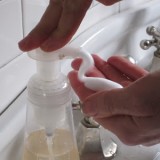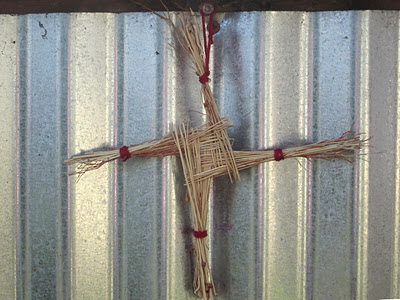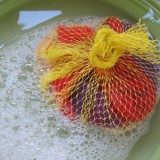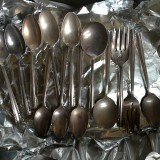 |
| Check out the water after boiling my supposedly clean sheet! |
As usual, I’m taking my shibori challenge right to the deadline. One important preparatory step to dyeing is a cleansing process called “scouring.” I’d never heard of this before now, which may be why all my casual attempts at dyeing thus far have not turned out so great. I spent my weekend scouring so I can move on to dyeing. And then on to sewing! Yikes! I’m really behind.
Scouring is deep cleaning of fabric or fiber. Scouring helps assure even color and good penetration of the dye. Cotton in particular needs scouring, even if it is brand new from the fabric shop, because apparently it is full of hidden waxes and oils. In my case, I’ll be using an old top sheet for my experiments, so it certainly needs lots of help.
Cotton and wool are scoured differently. I’ve never scoured wool, so am not going to cover it here. I understand it is also a washing process, but done with cool-ish water, so as not to felt the wool, and gentle soap. Linen also needs scouring, but I know even less about that.
My primary sources for this are:
- The Art and Craft of Natural Dyeing: Traditional Recipes for Modern Use
by J.N. Liles
- The Handbook of Natural Plant Dyes by Sasha Duerr
HOW TO SCOUR COTTON
You need:
1) A big non-reactive cooking pot, big enough so the fabric will not be crowded. I used our enamel canning pot.
2) Sodium Carbonate aka Washing Soda aka Soda Ash aka Sal Soda. This can be hard to find. It belongs in laundry aisles, and Arm & Hammer sells it (calling it Washing Soda), but few supermarkets actually bother to carry it, which annoys me to no end. You can also buy it wherever dye-stuff is sold. If you plan to use a lot of it, you could probably get it for cheap in large quantities from chemical suppliers.
3) Fabric detergent or liquid soap or dish soap. Beware of any additives in what you use, such as softeners or brighteners (in laundry detergent) or moisturizers (in liquid soap) which might leave residues on the fabric. Remember, you’re trying to strip the fabric clean. Use the simplest stuff you can find. I used our greywater-friendly Oasis detergent. It’s very basic. If I didn’t have that, I’d have turned to Bronner’s Sal Suds or dish soap.
How to:
How much water should you use? The fabric has to have lots of room. If you pack it into the pot it won’t clean properly. Liles recommends 1 quart of water per ounce of cotton yarn and 2 quarts per ounce of cotton fabric. This may mean you’ll have to scour in batches to do it properly. Allow time for this.
Recommended quantities of soap and soda vary somewhat from source to source. Personally, I don’t think the exact ratios are all that important. You’re using washing soda and detergent and heat to launder the living bejezus out of your fabric and there’s a lot of leeway in that.
That said: For each gallon of water in your pot, add anywhere between 2 to 3 teaspoons of washing soda (3 teaspoons is a tablespoon) and 1 to 2 teaspoons of detergent. Again, that’s per gallon of water, not per pot.
Washing soda is somewhat caustic, so be careful when you use it. It won’t burn your skin off if some of the wash water splashes on your hands when you’re stirring, but it is harsh and drying. You’re supposed to wear gloves when working with it.
Add the fabric and turn on the heat. Bring the water to a simmer and keep it there for a minimum of two hours. Four hours would be better if you can swing it. Stir the fabric occassionally with a long wooden spoon to make sure it launders evenly. The water will turn this ghastly yellow brown color. It made me want to boil all of my laundry, old-skool style.
When you figure it’s ready or you’ve decided you don’t want to watch it anymore, rinse the fabric very thoroughly in cold water.
From this point you can go straight on to the dying process with the fabric wet, or you can dry it and store it.






I was shocked last week when I found Sodium Carbonate at a local Walmart here in Las Vegas. I had looked last year at another Walmart (I don’t go very often) and hadn’t seen it.
Will have to try this, thanks!
So, that is your pot with fabric and brown water at the head of your post? Ick! kept looking, trying to figure out what was in the picture. That makes me want to go boil some clothing, too.
cool!
wow, I wish I would have known this about scouring before I dyed my duvet cover…. the dye I used just said to wash it well in hot water prior to dying, but after washing the duvet a few times, the color just isn’t holding. so I could see how a could “scour” could really help get a clean base!
When I used to make tie-dyes, I would wash the whites on hot with washing soda, and rescue the load after the first spin cycle, i.e. don’t give the machine the chance to rinse it. Then tie-dye. After it’s done dyeing (let it sit 24 hours after you dye it), you can launder it a couple times. You can then use Synthrapol soap to set the dye more, but it’s really not necessary.
Thanks for the information! Will have to remember next time I dye something.
This is super interesting to me. We have easy access to washing soda at our co-op in Montreal (La Maison Verte–“The Green House”!), and I have a big bag of it in the closet. I don’t know if you know the answer to this, but I will ask–If I take all my daughter’s white school uniform shirts that are covered in stains, and I do this with them, will it remove the stains? And if not, and I go through this process, will I just set the stains in more? I’m seriously about to go start cooking some clothes right this minute…
You know, washing soda is really all about lifting grease and oil, not stains per se. Unless maybe the stains are grease??? And right– non grease stains just might be set more. I find a good soak in peroxide-based bleach best for stains.
Pingback: Failed Experiment: Bermuda Buttercup or Sour Grass (Oxalis pes-caprae) as Dye | Root Simple
I have trouble buying washing soda, but I make it by baking baking soda at 400 F or higher. I just put a dish of it in with bread. It’s a great way to stretch and dilute automatic dishwashing powder.
Some chemistry:
There’s a spectrum from soda ash (sodium oxide) through lye (sodium hydroxide) and washing soda (sodium carbonate, i.e. two sodium ions for every carbonate radical) on to sodium bicarbonate (i.e., one hydrogen ion and one sodium ion for every carbonate radical). You can think of it as artificial processes adding energy to drive the sodium out of balance and make it more caustic, and atmospheric chemicals like water and carbon dioxide absorbing that energy and neutralizing the pH step by step.
High temperature breaks up carbonate radicals, transforming them to carbon dioxide. Very high temperatures would result in a pure oxide, a process known as “calcining” (first “c” is hard, last “c” is soft; like “calcium”, this word refers to the Latin word for burnt lime, and/or the word for pebbles). Moderately-high temperatures, the sort you could achieve in an oven, only release the half of the carbonate that’s more loosely bound to the baking soda. Wood ash starts out completely calcined; I bet old-school dyers used to scour linen, hemp, and cotton in either diluted lye, or lye baths which had transformed to washing soda by absorbing atmospheric CO2.
Thank you so much for explaining all that, Joel. A working knowledge of chemistry is really useful for a DIYer, and I’ve often regretted how little I know.
I’ve heard about making washing soda by baking baking soda, but was not sure if it really worked or was some internet old wives-tale. Good to hear it confirmed by someone who knows his chemistry. How long do you cook the baking soda? Sounds like about an hour, if it goes in with your bread?
It’s really a nice and useful piece of info. I am happy that you shared this helpful info with us. Please stay us informed like this. Thanks for sharing.
Does anyone know if scrubbing (between the heat and soda ash) will damage silkscreens/heat transfers. I want to dye some t shirts (one new, others old) with designs on them, but don’t want to damage the designs. Thanks.
Hi, I have a question! I forgot to put the dish soap in my scouring bath.. it got to the yellow/brown color and I let it sit for 2 hours… Do you think I need to re-scour? 🙁
What about silk chiffon – does it need to be “scrubed” like cotton? Love all your info and research…thanks a bunch.
I’m such a beginner at this–I really can’t advise you well about silk. I’d say no to this kind of scouring with heat and chemicals, since it is so delicate, but I don’t know if it needs any other prep or not.
Pingback: Shibori Tie-Dye with Natural Dyes
Hello I’m very new fixing to do this for the first time. I don’t use laundry soap, BC all the dyes and perfumes in it irritate me. So what is the purest, soap to use?? Can I use something like baking soda or what would be my best option for a dye free, perfume free, sensitive skin soap? And I’m quite confused on how much water to use, can u clarify a bit or should I just reread lol I’m 35 weeks pregnant so my brain isn’t working well right now.
There are dye and scent free laundry detergents on the market. Any of those would work. What do you use to wash your clothes now? Note you can also use dish soap or liquid soap. Baking soda is useful, but not a substitute for detergent. The quantities don’t have to be exact. I was shoving the cloth in a big stock pot.